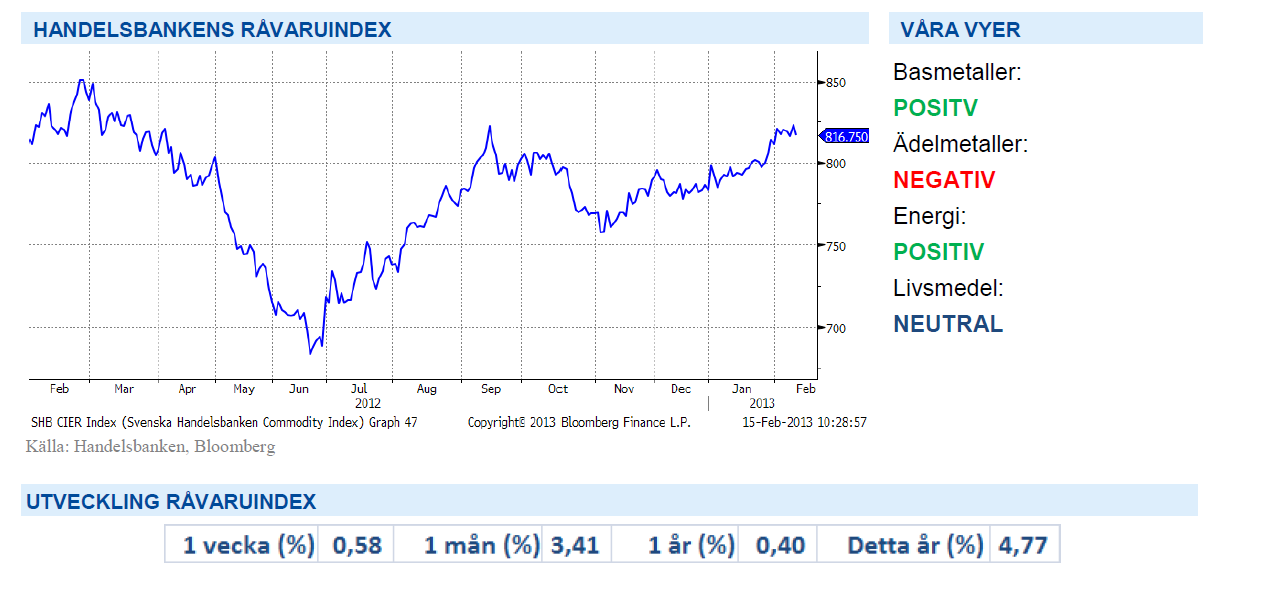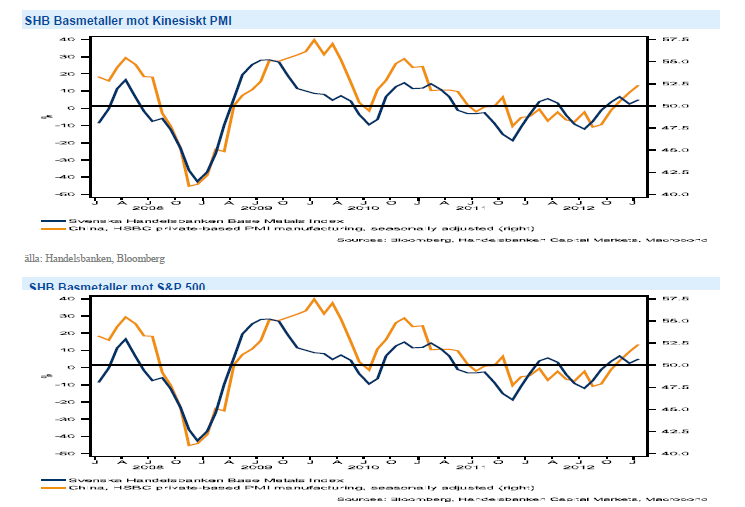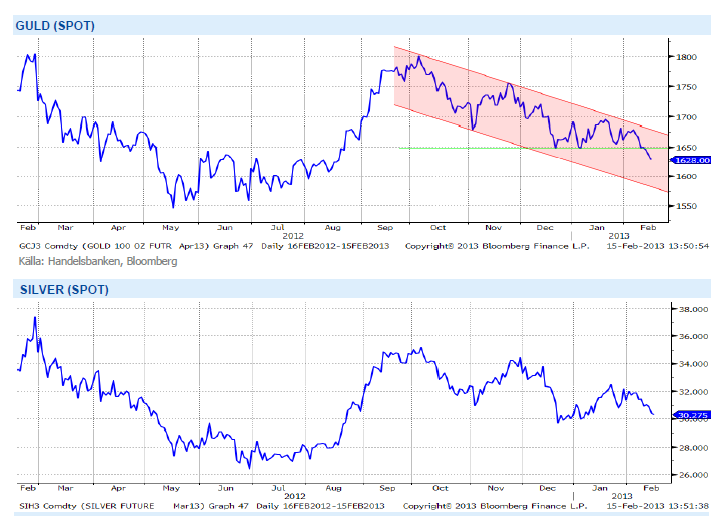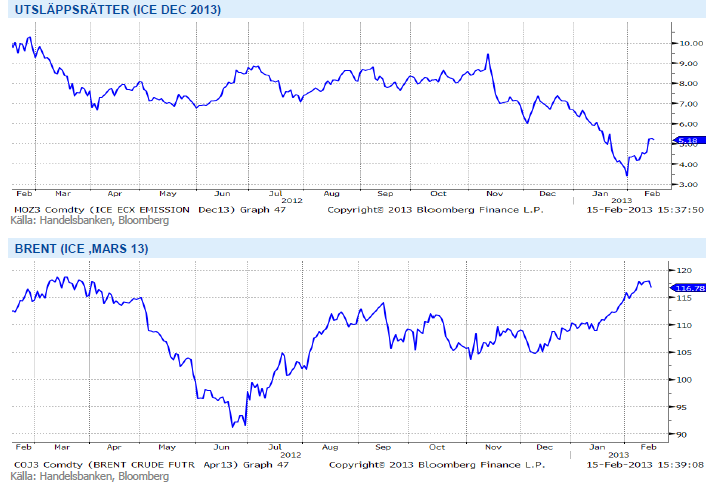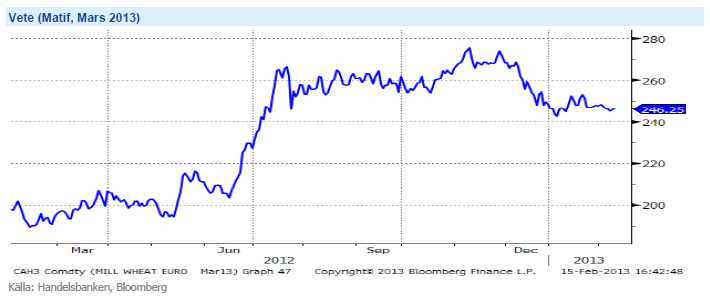Analys
SHB Råvarubrevet 15 februari 2013

 Intressant vecka trots kinesisk nyårsledighet!
Intressant vecka trots kinesisk nyårsledighet!
Vi hade väntat oss en lugn vecka på råvarumarknaden när kineserna hade ledigt efter söndagens nyårsfest. Volymerna har visserligen varit lägre men det har ändå varit intressanta rörelser. Guld bröt ner genom sitt starka tekniska motstånd på 1545 och vi skickade idag ut en handels ide där vi tycker att man ska sälja guld med 1550 som mål. Att sälja guld nu är logiskt med vår tro på en starkare konjunktur och en utbredd ”risk on” mentalitet på marknaderna. Vi sätter också större tilltro till de tekniska signalerna för guld än för övriga råvaror då guld har mindre fasta kopplingar till den fundamentala bilden. Vår tro på starkare oljepris håller i sig och under veckan har Brent åter varit uppe över 119 USD. Inte mycket nytt kom ut från Iranmötet i tisdags utan sanktionerna mot Irans oljeexport till USA och EU ligger kvar. Inga nya möten är planerade.
Aluminium nådde ett nytt friskt månadshögsta under veckan på 2166.5 och basmetallerna ser starka ut trots kinesernas frånvaro. Nu krävs att kinas metallhandlare fortsätter köpvågen när de återvänder till handlarborden på måndag.
Basmetallerna
Metaller i fokus
Vårt basmetallindex ligger kvar oförändrat under en förhållandevis lugn vecka och Kinesiskt nyår. Aluminium noteras på månadshögsta samtidigt som ett antal aktörer minskat ned sina contango-positioner, dvs lagrat och finansierat Aluminium och sen låst in en ca 5 procent i årlig avkastning genom att rulla terminerna. Eftersom det är så lugnt på basmetaller kan vi passa på att berätta om en positiv utveckling på den finansiella järnmalmsmarknaden där omsättningen fortsätter att öka. 100 miljoner ton omsattes 2012 (ca 1/10 av den fysiskt handlade) och vi ser ett ökande intresse från investerare. Positivt även för finansiella skrotkontrakt men för färdiga stål är det egentligen bara SHFE som lyckats med sitt Rebar kontrakt, övriga och däribland LME har svårt att attrahera industrins intresse.
Vi tror på fortsatt styrka i konjunkturen och att högre priser kommer nås under slutet av februari. Denna bild har bekräftats av makrodata och fått investerare att allokera om sina portföljer från defensiva positioner till mer konjunkturdrivna råvaror som olja och basmetaller. Basmetaller är ett enkelt sätt att exponera sig mot den ekonomiska utvecklingen i Kina (se Kinas PMI och SHB Basmetaller nedan). En annan intressant bild (se nedan) är den mellan SHB Basmetaller och S&P 500 där vi förväntar oss att gapet kommer ihop på sikt.
Den globala tillväxten har fått ny kraft och gynnar konjunkturkänsliga råvaror som basmetaller. Vi tror på: BASMET H
Ädelmetaller
Sälj guld på bättre konjunktur
Guld har 12 år med stigande pris i ryggen och blivit råvaran som inte kan gå ner. Under 2012 nådde guld sin högsta nivå 1794 USD/oz under oktober när QE3 yran var som värst. Därefter har guldet hamnat i en fallande trend. Många analytiker räknade med att debaclet kring USA:s skuldtak skulle ge priset stöd under början av året. Så har inte varit fallet och vi ser nu flera skäl till att guldet kommer fortsätta falla nedåt. Sedan de första positiva signalerna kom från Kina i september har bilden av en allt bättre global konjunktur börjat sprida sig. Denna bild har bekräftats av makrodata och fått investerare att allokera om sina portföljer från defensiva positioner till en mer risksökande inriktning. I denna omallokering ingår att lämna guld för ”risk on” tillgångar som aktier och andra mer konjunkturdrivna råvaror som olja och basmetaller. Dessa flöden tro vi kommer fortsätta under våren när finansmarknaden dansar till allt gladare toner från bättre konjunkturdata.
Under senaste veckorna har olja handlats upp samtidigt som guld handlats ner. Det är en klassisk indikator på att en ljusare framtid är här. Tekniskt står guld nu på ett mycket viktigt stöd och fallhöjden är ner till 1530 om guld bryter under 1645. Uppåt tycker vi att en stopp på 1705 är att rekommendera.
Med fortsatt positivt risksentiment och potentiellt stigande räntenivåer ser vi nästa stora rörelse kommer att vara nedåt. Vi tror på GULD S H
Energi
Starkt sentiment på oljan
Fundamentalt inga större förändringar på oljemarknaden men en ökad oro för att planlagda underhåll på amerikanska raffinader kommer att förvärra lagersituationen på bensin ytterligare i kombination med positiva sysselsättningssiffror ger stöd. Vi är fortsatt positiva till oljan där en rad faktorer som global tillväxt och risk för produktionsbortfall men framför allt en ökad riskaptit som ser ut att tillfälligt kunna driva brentoljan en bit över 120 dollar. En osäker faktor på lite längre sikt är skifferoljan (se bifogad bilaga) där produktionen överträffat alla prognoser framför allt i USA vilket naturligtvis är kopplat till USAs mål om att vara självförsörjande på energi framöver. Utvinningen är dock omstridd och det finns all anledning att tro att miljöfrågorna kommer att hamna mer i fokus.
Elen handlas oförändrat över veckan där fokus varit på utsläppsmarknaden och miljöutskottets möte i veckan som kommer. Sannolikt att vi får någon form av backdrop, dvs förskjuten tilldelning mot slutet av fasen, av de ca 900 miljoner ton som diskuteras men svårt att säga vad det innebär konkret förens parlamentet godkänner förslaget. Det talas om nivåer på uppemot 15 euro per ton vilket skulle innebära ca 7 öre extra på elpriset från dagens nivåer men vår gissning är att de fortsätter att stiga något till fram till mötet för att sedan successivt börja falla tillbaka på vinsthemtagning och osäkerhet om nästa fas och liggar kvar på nivåer strax över 5 euro.
Den råvarugrupp som är mest beroende av den globala konjunkturen är Energi och med en starkare konjunktur ser vi positivt på utvecklingen för denna sektor. Vi tror på: ENERGI H
Livsmedel
Oron långt ifrån över för Vetet
Terminspriserna på vete noteras ned sedan förra veckan i både Chicago och Paris. Nedgången har delvis påverkats av fortsatta skurar på det amerikanska höstvetet, dock har det ännu inte fallit några större mängder för att göra märkbar skillnad och oron är långt ifrån över. Nästa vecka ser det dessutom ut att bli torrt med endast väldigt små regnmängder, inte alls idealiskt för grödorna. Trots nedgång för veckan som helhet stiger priserna under fredagen, delvis som följd av amerikanska exportsiffror som rapporterats in på högre nivå än väntat – vilka i sin tur påverkas av att de amerikanska vetepriserna nu handlas på lägsta nivå på över sju månader.
I EU bedöms allt fortfarande vara helt ok. Enligt franska officiella siffror är landets höstveteareal upp cirka tre procent från förra årets. I en del områden i Europa har snön regnat bort men temperaturen är relativt hög och ser ut att förbli så framöver. I Ukraina har det blivit lite kallare igen men generellt sett är snötäcket tillräckligt tjockt för att skydda grödorna. I Ryssland bedöms läget generellt sett också vara ok, lite kallare i de norra och centrala delarna men gott om snö och i söder något för torrt men utan större oro. Höstvetet i USA är i riktigt dåligt skick och nederbörden ser ut att bli väldigt begränsad under kommande vecka. I andra veteregioner i världen råder dock inga större problem vilket ger viss press nedåt på priserna. Än finns det dessutom tid för regn att falla inför sådd av majs i USA – vilket spannmålsmarknaden lägger stort fokus på för tillfället. Vetet handlas nu på de lägsta nivåerna sedan juni/juli 2012, givet inga större väderproblem (vilket vi dock blivit ganska vana vid) bör vi kunna vänta oss fortsatt lägre priser lite längre fram på året.
Socker
Sockerpris på nivåer som närmar sig produktionskostnaden, produktions fall i Thailand och ökad efterfrågan på etanol får oss att tro på BULL SOCKER H
Handelsbankens Råvaruindex
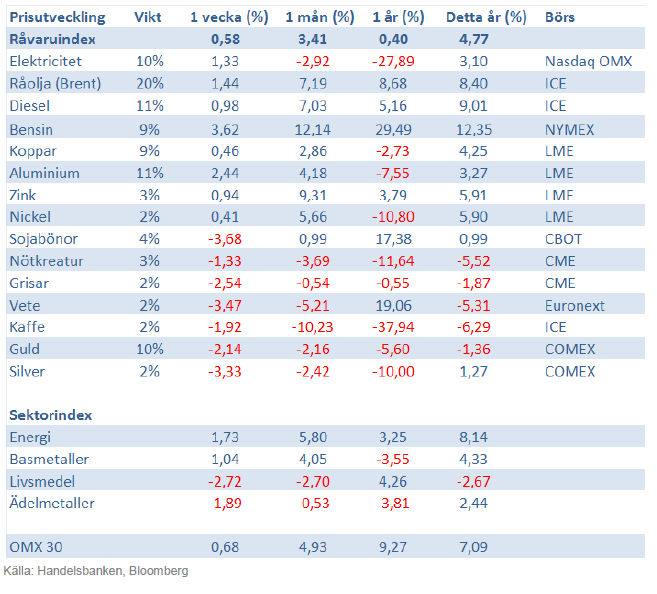
Handelsbankens råvaruindex består av de underliggande indexen för respektive råvara. Vikterna är bestämda till hälften från värdet av global produktion och till hälften från likviditeten i terminskontrakten.
[box]SHB Råvarubrevet är producerat av Handelsbanken och publiceras i samarbete och med tillstånd på Råvarumarknaden.se[/box]
Ansvarsbegränsning
Detta material är producerat av Svenska Handelsbanken AB (publ) i fortsättningen kallad Handelsbanken. De som arbetar med innehållet är inte analytiker och materialet är inte oberoende investeringsanalys. Innehållet är uteslutande avsett för kunder i Sverige. Syftet är att ge en allmän information till Handelsbankens kunder och utgör inte ett personligt investeringsråd eller en personlig rekommendation. Informationen ska inte ensamt utgöra underlag för investeringsbeslut. Kunder bör inhämta råd från sina rådgivare och basera sina investeringsbeslut utifrån egen erfarenhet.
Informationen i materialet kan ändras och också avvika från de åsikter som uttrycks i oberoende investeringsanalyser från Handelsbanken. Informationen grundar sig på allmänt tillgänglig information och är hämtad från källor som bedöms som tillförlitliga, men riktigheten kan inte garanteras och informationen kan vara ofullständig eller nedkortad. Ingen del av förslaget får reproduceras eller distribueras till någon annan person utan att Handelsbanken dessförinnan lämnat sitt skriftliga medgivande. Handelsbanken ansvarar inte för att materialet används på ett sätt som strider mot förbudet mot vidarebefordran eller offentliggörs i strid med bankens regler.
Analys
Tightening fundamentals – bullish inventories from DOE

The latest weekly report from the US DOE showed a substantial drawdown across key petroleum categories, adding more upside potential to the fundamental picture.

Commercial crude inventories (excl. SPR) fell by 5.8 million barrels, bringing total inventories down to 415.1 million barrels. Now sitting 11% below the five-year seasonal norm and placed in the lowest 2015-2022 range (see picture below).
Product inventories also tightened further last week. Gasoline inventories declined by 2.1 million barrels, with reductions seen in both finished gasoline and blending components. Current gasoline levels are about 3% below the five-year average for this time of year.
Among products, the most notable move came in diesel, where inventories dropped by almost 4.1 million barrels, deepening the deficit to around 20% below seasonal norms – continuing to underscore the persistent supply tightness in diesel markets.
The only area of inventory growth was in propane/propylene, which posted a significant 5.1-million-barrel build and now stands 9% above the five-year average.
Total commercial petroleum inventories (crude plus refined products) declined by 4.2 million barrels on the week, reinforcing the overall tightening of US crude and products.


Analys
Bombs to ”ceasefire” in hours – Brent below $70

A classic case of “buy the rumor, sell the news” played out in oil markets, as Brent crude has dropped sharply – down nearly USD 10 per barrel since yesterday evening – following Iran’s retaliatory strike on a U.S. air base in Qatar. The immediate reaction was: “That was it?” The strike followed a carefully calibrated, non-escalatory playbook, avoiding direct threats to energy infrastructure or disruption of shipping through the Strait of Hormuz – thus calming worst-case fears.

After Monday morning’s sharp spike to USD 81.4 per barrel, triggered by the U.S. bombing of Iranian nuclear facilities, oil prices drifted sideways in anticipation of a potential Iranian response. That response came with advance warning and caused limited physical damage. Early this morning, both the U.S. President and Iranian state media announced a ceasefire, effectively placing a lid on the immediate conflict risk – at least for now.
As a result, Brent crude has now fallen by a total of USD 12 from Monday’s peak, currently trading around USD 69 per barrel.
Looking beyond geopolitics, the market will now shift its focus to the upcoming OPEC+ meeting in early July. Saudi Arabia’s decision to increase output earlier this year – despite falling prices – has drawn renewed attention considering recent developments. Some suggest this was a response to U.S. pressure to offset potential Iranian supply losses.
However, consensus is that the move was driven more by internal OPEC+ dynamics. After years of curbing production to support prices, Riyadh had grown frustrated with quota-busting by several members (notably Kazakhstan). With Saudi Arabia cutting up to 2 million barrels per day – roughly 2% of global supply – returns were diminishing, and the risk of losing market share was rising. The production increase is widely seen as an effort to reassert leadership and restore discipline within the group.
That said, the FT recently stated that, the Saudis remain wary of past missteps. In 2018, Riyadh ramped up output at Trump’s request ahead of Iran sanctions, only to see prices collapse when the U.S. granted broad waivers – triggering oversupply. Officials have reportedly made it clear they don’t intend to repeat that mistake.
The recent visit by President Trump to Saudi Arabia, which included agreements on AI, defense, and nuclear cooperation, suggests a broader strategic alignment. This has fueled speculation about a quiet “pump-for-politics” deal behind recent production moves.
Looking ahead, oil prices have now retraced the entire rally sparked by the June 13 Israel–Iran escalation. This retreat provides more political and policy space for both the U.S. and Saudi Arabia. Specifically, it makes it easier for Riyadh to scale back its three recent production hikes of 411,000 barrels each, potentially returning to more moderate increases of 137,000 barrels for August and September.
In short: with no major loss of Iranian supply to the market, OPEC+ – led by Saudi Arabia – no longer needs to compensate for a disruption that hasn’t materialized, especially not to please the U.S. at the cost of its own market strategy. As the Saudis themselves have signaled, they are unlikely to repeat previous mistakes.
Conclusion: With Brent now in the high USD 60s, buying oil looks fundamentally justified. The geopolitical premium has deflated, but tensions between Israel and Iran remain unresolved – and the risk of missteps and renewed escalation still lingers. In fact, even this morning, reports have emerged of renewed missile fire despite the declared “truce.” The path forward may be calmer – but it is far from stable.
Analys
A muted price reaction. Market looks relaxed, but it is still on edge waiting for what Iran will do

Brent crossed the 80-line this morning but quickly fell back assigning limited probability for Iran choosing to close the Strait of Hormuz. Brent traded in a range of USD 70.56 – 79.04/b last week as the market fluctuated between ”Iran wants a deal” and ”US is about to attack Iran”. At the end of the week though, Donald Trump managed to convince markets (and probably also Iran) that he would make a decision within two weeks. I.e. no imminent attack. Previously when when he has talked about ”making a decision within two weeks” he has often ended up doing nothing in the end. The oil market relaxed as a result and the week ended at USD 77.01/b which is just USD 6/b above the year to date average of USD 71/b.

Brent jumped to USD 81.4/b this morning, the highest since mid-January, but then quickly fell back to a current price of USD 78.2/b which is only up 1.5% versus the close on Friday. As such the market is pricing a fairly low probability that Iran will actually close the Strait of Hormuz. Probably because it will hurt Iranian oil exports as well as the global oil market.
It was however all smoke and mirrors. Deception. The US attacked Iran on Saturday. The attack involved 125 warplanes, submarines and surface warships and 14 bunker buster bombs were dropped on Iranian nuclear sites including Fordow, Natanz and Isfahan. In response the Iranian Parliament voted in support of closing the Strait of Hormuz where some 17 mb of crude and products is transported to the global market every day plus significant volumes of LNG. This is however merely an advise to the Supreme leader Ayatollah Ali Khamenei and the Supreme National Security Council which sits with the final and actual decision.
No supply of oil is lost yet. It is about the risk of Iran closing the Strait of Hormuz or not. So far not a single drop of oil supply has been lost to the global market. The price at the moment is all about the assessed risk of loss of supply. Will Iran choose to choke of the Strait of Hormuz or not? That is the big question. It would be painful for US consumers, for Donald Trump’s voter base, for the global economy but also for Iran and its population which relies on oil exports and income from selling oil out of that Strait as well. As such it is not a no-brainer choice for Iran to close the Strait for oil exports. And looking at the il price this morning it is clear that the oil market doesn’t assign a very high probability of it happening. It is however probably well within the capability of Iran to close the Strait off with rockets, mines, air-drones and possibly sea-drones. Just look at how Ukraine has been able to control and damage the Russian Black Sea fleet.
What to do about the highly enriched uranium which has gone missing? While the US and Israel can celebrate their destruction of Iranian nuclear facilities they are also scratching their heads over what to do with the lost Iranian nuclear material. Iran had 408 kg of highly enriched uranium (IAEA). Almost weapons grade. Enough for some 10 nuclear warheads. It seems to have been transported out of Fordow before the attack this weekend.
The market is still on edge. USD 80-something/b seems sensible while we wait. The oil market reaction to this weekend’s events is very muted so far. The market is still on edge awaiting what Iran will do. Because Iran will do something. But what and when? An oil price of 80-something seems like a sensible level until something do happen.
-

 Nyheter3 veckor sedan
Nyheter3 veckor sedanMahvie Minerals växlar spår – satsar fullt ut på guld
-

 Nyheter4 veckor sedan
Nyheter4 veckor sedanUppgången i oljepriset planade ut under helgen
-

 Nyheter4 veckor sedan
Nyheter4 veckor sedanLåga elpriser i sommar – men mellersta Sverige får en ökning
-

 Nyheter3 veckor sedan
Nyheter3 veckor sedanOljan, guldet och marknadens oroande tystnad
-

 Analys3 veckor sedan
Analys3 veckor sedanA muted price reaction. Market looks relaxed, but it is still on edge waiting for what Iran will do
-

 Nyheter3 veckor sedan
Nyheter3 veckor sedanJonas Lindvall är tillbaka med ett nytt oljebolag, Perthro, som ska börsnoteras
-

 Analys4 veckor sedan
Analys4 veckor sedanVery relaxed at USD 75/b. Risk barometer will likely fluctuate to higher levels with Brent into the 80ies or higher coming 2-3 weeks
-

 Nyheter3 veckor sedan
Nyheter3 veckor sedanDomstolen ger klartecken till Lappland Guldprospektering


